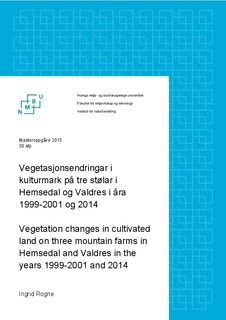| dc.description.abstract | To stølar i Valdres og ein støl i Hemsedal var i 1999-2001 ein del av
prosjektet "Levande stølar" i regi av Norges Vel. I den samanheng vart det lagt ut tjue
analyseruter på kvar støl, skilde i to ulike biotopar med ti ruter på kvar. Ein
nøkkelbiotop der vegetasjonen bar særleg preg av kulturmark, og ein beitebiotop
lenger frå stølen som vart beita periodevis. I 1999-2001 vart desse rutene analyserte
både for artsdiversitet og dekningsgrad, samt vegetasjonshøgde, jorddjubde og
strøsjikt. Det vart i 2014 gjort ei tilsvarande registrering i dei same rutene for å sjå på
utviklinga til biotopane over ei 15-årsperiode. Attgroinga var merkbar i 1999-2001,
men biotopane har hatt ulik utvikling fram mot 2014, avhengig av beiting og
menneskeleg skjøtsel.
Det er i denne oppgåva sett på korleis artstal og artsdiversitet har endra seg i
løpet av av dei 15 åra mellom 1999 og 2014. Endringane er nærare undersøkte og
knytte til vegetasjonsregistreringar, særleg dekningsgrad og høgde. Det er også gått
inn på enkeltartar som har forsvunne på biotopane mellom 1999 og 2014, samt artar
som dominerte biotopane i 1999-2001, samanlikna med vegetasjonsbilete i 2014. Med
bakgrunn i dette er det forsøkt å plassere områda i suksesjonsprosessen, både i 1999-
2001 og i 2014.
I 1999-2001 var det mjølkekyr på alle stølane, og biotopane vart nytta som
beite. Fire av dei seks biotopane vart ikkje nytta til beite i 2014. Registreringane synte
at attgroinga på alle biotopane hadde kome lenger i 2014 enn i 1999-2001, men har
gått saktast på den stølen der biotopane framleis blir beita. Dei biotopane som var
mest artsrike i 1999-2001, har fram mot 2014 hatt det største tapet av artar, mens dei
mest fattige biotopane ikkje har hatt vesentlege endringar. Tap av biologisk mangfald
i forhold til artar og genetisk variasjon var stor på alle stølane, og i dei fleste tilfelle
må det kraftige restaureringstiltak til for å redde kulturmarka frå attgroing av einer,
vier, dverg- og fjellbjørk. Når bruken opphøyrer, fører naturen området tilbake til det
opprinnelege, og innvandra kulturmarksartar døyr ut. Abstract
Two mountain farms in Valdres and one in Hemsedal were included in the
project "Levande stølar" directed by Norges Vel. Twenty plots in each area were
randomly laid out, separated in two different biotopes. One biotope close to the
mountain farms where indicators of cultivated land were common and another
biotope, farther away from the mountain farms, that used to be grazed occasionally. In
the period 1999-2001 the plots were analyzed for species diversity, species
abundance, height of the field layers, soil depth and litter layer depth. In 2014
identical investigations were taken to discuss changes in the biotopes during a 15
years period.
Already in 1999-2001 the overgrowth was visible, but the development up to
2014 was individual for each biotope, because of different changes in grazing
situation and human management. This study contains changes in number of species
and diversity during the 15 years 1999-2014 and attempts to explaine the reasons of
the development for each biotope with vegetation registrations, especially the cover
ratio and height. It also discusses individual species that have disappeared from 1999
to 2014 and the most dominating species in the vegetation in 1999-2001 and 2014.
With this information the biotopes are placed in categories of succession.
In the period 1999-2001 all the biotopes were grazed by dairy cattle. Four of
six biotopes did not have grazers in 2014. The registrations show an overgrowth in all
biotopes, more distinctive in 2014 than in 1999-2001. The overgrowth seemed to slow
down in the grazed biotopes. The biotopes with highest species diversity in 1999-
2001 had the largest decrease in number of species up to 2014.
Loss of biodiversity is noticeable in all biotopes and restoration measures are
required to save the cultivated fields from juniper, willow, dwarf- and mountain birch.
The nature leads the biotopes back to the origin and immigrated cultivated species
will disappear. | nb_NO |
